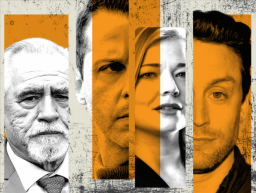At the close of its fourth and final season, “Succession” occupies a place eerily analogous to that of fearsome patriarch Logan Roy. After Logan’s sudden, shocking death in the third episode, his colleagues and children (who were also his colleagues) had to scramble for an answer to the question that’s haunted the entire series: What — or rather, who — now? “Succession” itself is set to leave a Logan-sized hole in the cultural landscape, with its fan base asking the same question.
The future is impossible to predict, as “Succession” so beautifully showed with its anticlimactic, out-of-nowhere take on Logan’s demise. Ahead of the May 28 series finale, however, we can look back on what made the show such an era-defining, Emmy-dominating hit. “Succession” is hardly the first to explore the inner lives of the ultrarich. But at the end of its run, it stands out as the least glamorous and most realistic of the genre. It’s also the most effective as social commentary: By zooming in on the Roys’ claustrophobic bubble and toxic family dynamic, “Succession” speaks to the world they helped shape in their image.
The mark of an all-time TV character is a portrait so complete it feels four-dimensional, with their quirks, traumas and complexes so established the viewer can envision how they’d react in some unseen situation. Over the course of “Succession,” creator Jesse Armstrong and his collaborators turned each of the Roys and their cronies into people we can, if not like, at least feel we deeply understand — more so, in fact, than their real-life inspirations. Armstrong famously penned an unproduced script about the Murdoch family before signing on with HBO. (The network had made its mark with “The Sopranos,” a story about a different kind of family business; with “Succession,” it would up- date the formula for the age of Fox News.) But by making the Roys an amalgam of dynastic wealth, from the Trumps to the Kennedys to everyone in between, “Succession” could pick and choose reference points to work into a more specific, original story. The result is a more convincing psychological profile of the .0001% than any attempt to peer inside the private lives of public figures we’ll never truly know.
The eponymous question that’s driven “Succession,” at least on the surface, is who will take over from Logan as CEO of the sprawling media empire Waystar Royco. Will it be Kendall, the longtime heir apparent prone to mania and substance abuse? Will it be Roman, the puerile edgelord who may have the mean streak to do what Kendall can’t? Will it be Siobhan, the faux-feminist smart enough to forge her own path until she suddenly, disastrously isn’t? Could it even be Connor, their older half-brother largely content to play with his Napoleon relics and finance his escort girlfriend’s (now wife’s) awful plays? Or Cousin Greg, the oafish hanger-on, or Tom Wambsgans, Shiv’s social-climbing, Greg-abusing husband with a surprisingly sensitive side? From season to season, episode to episode and even scene to scene, the contenders passed front-runner status back and forth like a hot potato.
The guessing game drew such intense interest thanks to a uniformly excellent cast, many so relatively unknown that, with the help of their considerable talent, they all but became their characters in the eyes of viewers. Jeremy Strong, whose acting style was so immersive it occasioned an unflattering profile in The New Yorker, was Kendall. Brian Cox gave cranky comments about Strong to the press, creating the impression the Roys’ Oedipal struggle extended beyond the screen set. As Tom, Matthew Macfadyen managed to erase all memory of no less an iconic role than Mr. Darcy of “Pride and Prejudice,” instead delivering a more transactional, twisted take on romantic love.
But “Succession,” both premise and show, has been something of a bait-and-switch. Whoever ends up in the corner office will be left with Logan’s personal legacy, not just his professional one. The real issue is not who can or should replace Logan. It’s whether the surviving Roys can overcome the violent, selfish, abrasive hand they’ve been dealt or if, as Kendall posits to his sister in a recent episode, “the poison drips through.” This exchange takes place in the office, because there are no boundaries between the family and the company that bears their name. It’s an elision at the heart of their privilege and problems alike: All the Roys’ relationships are fruit, to borrow Kendall’s metaphor, of the same poisoned tree.
“Succession” is a tragedy because breaking the cycle of familial abuse has always been a pipe dream; “Succession” is a comedy because of how the show illustrates that truth. The diamond-sharp scripts are an indelible mix of erudition — bags aren’t big, they’re “ludicrously capacious” — and inarticulate bluster, the Roys stammering in strings of “ums” and “yeahs.” The direction, established by Adam McKay in the pilot and then led by executive producer Mark Mylod, is hyperactive and deliberately un-stylized, focusing on anxious, greedy people rather than the gorgeous spaces they inhabit. Visually, the show looks more like a vérité-style cringe sitcom (such as “The Thick of It,” where Armstrong once worked as a writer) than an escapist fantasy.
A vicious sense of humor has helped “Succession” dodge potential accusations of glamorizing the plutocratic Roys. It also has captured a more truthful snapshot of capitalism at its most cruel, one with insights that will endure well beyond the series’ conclusion. Season 4’s penultimate episode is titled “Church and State,” as in “separation of.” The irony of the name, and the show, is that there is no separation, and never was. “Succession” was never just funny or sad, or just about any one theme — the media, inequality, trauma, America, take your pick. The show was everything bundled up together, just as it always is.
Read More About:
Source: Read Full Article
